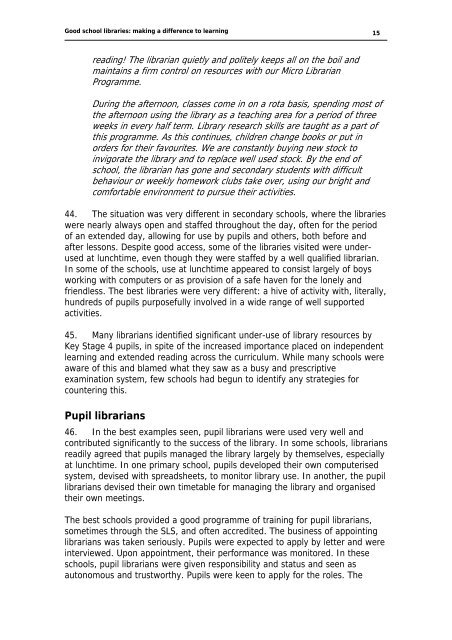Good school libraries: - Digital Education Resource Archive (DERA)
Good school libraries: - Digital Education Resource Archive (DERA)
Good school libraries: - Digital Education Resource Archive (DERA)
You also want an ePaper? Increase the reach of your titles
YUMPU automatically turns print PDFs into web optimized ePapers that Google loves.
<strong>Good</strong> <strong>school</strong> <strong>libraries</strong>: making a difference to learning 15<br />
reading! The librarian quietly and politely keeps all on the boil and<br />
maintains a firm control on resources with our Micro Librarian<br />
Programme.<br />
During the afternoon, classes come in on a rota basis, spending most of<br />
the afternoon using the library as a teaching area for a period of three<br />
weeks in every half term. Library research skills are taught as a part of<br />
this programme. As this continues, children change books or put in<br />
orders for their favourites. We are constantly buying new stock to<br />
invigorate the library and to replace well used stock. By the end of<br />
<strong>school</strong>, the librarian has gone and secondary students with difficult<br />
behaviour or weekly homework clubs take over, using our bright and<br />
comfortable environment to pursue their activities.<br />
44. The situation was very different in secondary <strong>school</strong>s, where the <strong>libraries</strong><br />
were nearly always open and staffed throughout the day, often for the period<br />
of an extended day, allowing for use by pupils and others, both before and<br />
after lessons. Despite good access, some of the <strong>libraries</strong> visited were underused<br />
at lunchtime, even though they were staffed by a well qualified librarian.<br />
In some of the <strong>school</strong>s, use at lunchtime appeared to consist largely of boys<br />
working with computers or as provision of a safe haven for the lonely and<br />
friendless. The best <strong>libraries</strong> were very different: a hive of activity with, literally,<br />
hundreds of pupils purposefully involved in a wide range of well supported<br />
activities.<br />
45. Many librarians identified significant under-use of library resources by<br />
Key Stage 4 pupils, in spite of the increased importance placed on independent<br />
learning and extended reading across the curriculum. While many <strong>school</strong>s were<br />
aware of this and blamed what they saw as a busy and prescriptive<br />
examination system, few <strong>school</strong>s had begun to identify any strategies for<br />
countering this.<br />
Pupil librarians<br />
46. In the best examples seen, pupil librarians were used very well and<br />
contributed significantly to the success of the library. In some <strong>school</strong>s, librarians<br />
readily agreed that pupils managed the library largely by themselves, especially<br />
at lunchtime. In one primary <strong>school</strong>, pupils developed their own computerised<br />
system, devised with spreadsheets, to monitor library use. In another, the pupil<br />
librarians devised their own timetable for managing the library and organised<br />
their own meetings.<br />
The best <strong>school</strong>s provided a good programme of training for pupil librarians,<br />
sometimes through the SLS, and often accredited. The business of appointing<br />
librarians was taken seriously. Pupils were expected to apply by letter and were<br />
interviewed. Upon appointment, their performance was monitored. In these<br />
<strong>school</strong>s, pupil librarians were given responsibility and status and seen as<br />
autonomous and trustworthy. Pupils were keen to apply for the roles. The



